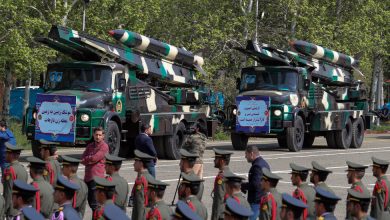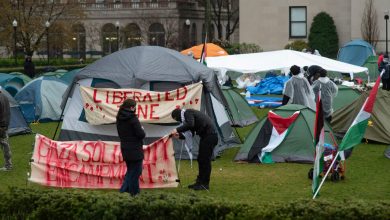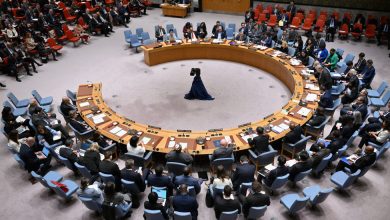In Hong Kong, China’s Covid Aid Gets the Cold Shoulder

HONG KONG — Soon after Omicron overwhelmed Hong Kong’s health care system in a deadly outbreak, Beijing rushed to help. Contractors from mainland China built vast isolation facilities. The central government sent more than 1,000 medical workers to staff treatment and testing centers, as well as butchers to help stabilize the local meat supply.
To the city’s Beijing-backed establishment, the aid from the central government was a godsend. Carrie Lam, the local leader, traveled to the border with the mainland to greet the arriving medics with a bow, a sign of deep gratitude rarely used in the city.
But to many people in both Hong Kong and mainland China, the outbreak has only exposed the political and cultural divide between the city, a former British colony that returned to Chinese control in 1997, and the rest of the country.
Some residents in Hong Kong have criticized the stringent Covid measures pushed by Beijing such as the centralized isolation of patients and widespread lockdowns of buildings, saying they undermined the city’s longstanding protections for individual liberties.
People in the mainland, though, depicted such attitudes as selfish and lacking the sense of national duty that is necessary to contain the virus.
University of Hong Kong researchers believe more than half of the city’s 7.5 million people have been infected. The extent of the outbreak has forced the government to back down on some of its stricter plans, such as imposing a lockdown to conduct mass testing. Many in the mainland were shocked when Hong Kong said it planned to loosen its Covid control measures even before it had curbed the outbreak.
“Let Hong Kong go ahead with the experiment. Just take back our medics and make sure our border is sealed,” Zhen Haoyuan, a prominent mainland Chinese commenter, wrote on Weibo, a popular Chinese social media platform.
The public backlash on both sides follows sweeping efforts by Beijing to bring Hong Kong more directly under the control of China’s central government. Beijing imposed a national security law in 2020 that stamped out widespread dissent and overhauled local election laws that decimated the pro-democracy opposition camp.
Beijing has depicted its contributions to Hong Kong’s epidemic response in political terms. Before the medical workers departed for Hong Kong, the ruling Communist Party’s flag was prominently displayed and the national anthem sung at ceremonies. Red banners that say “The central government supports Hong Kong, fight the pandemic with one heart” are prominently displayed on newly built quarantine facilities.
Many Hong Kong residents are unimpressed. On Facebook, a platform popular in Hong Kong but banned in the mainland, they have criticized the quarantine facilities as substandard, seizing on issues like the installation of squat toilets, which aren’t widely used in Hong Kong.
Cathy Fung, a 33-year-old former nurse who was sent to an isolation facility with her husband and her mother in early March when they tested positive, said the confinement was an unnecessary inconvenience.
“It really disturbed the daily lives of people,” she said. “What’s the difference between this and isolating ourselves at home?”
Ms. Fung wondered if the money spent on isolation facilities could have been better used, for example, by helping the unemployed. “Does Hong Kong really need this? Why couldn’t the Hong Kong government just say no?” she asked.
Mrs. Lam, the city’s leader, and other officials have said that deviating from the central government’s goal of eliminating local outbreaks is not an option. The city has sought — and so far failed — to bring infections down in order for the mainland to reopen its borders to Hong Kong.
Leung Pak-yin, the former chief executive of Hong Kong’s Hospital Authority, criticized the Hong Kong government in a Facebook post for blindly following mainland practices, relying on “the golden shield of political correctness” rather than science to guide its epidemic response.
Some Hong Kong medical workers have welcomed the help from the mainland.
Vincent Chong Wai-lam, a 41-year-old support team supervisor at a local public hospital, said he and his colleagues had been pushed to the limit by the outbreak. Because of the shortage of people and space, hospitals had been forced to leave bodies in wards near where other patients were being treated.
“In one night, I moved more than 80 bodies with another colleague. The whole hospital needs support from the mainland,” Mr. Chong said. He acknowledged, however, that his view wasn’t widely shared by his colleagues.
Local doctors have long resisted efforts to allow mainland medical staff to practice in Hong Kong, saying they lacked an understanding of local conditions and fluency in English, which is widely used in the city. The government used emergency powers last month to allow doctors and nurses from the mainland to practice in the city, which has a separate licensing system.
The public debate about the qualifications of mainland medics took an ominous turn when a reporter with a Hong Kong news outlet asked officials at a briefing how members of the public could file complaints against mainland doctors in the event of a mishap.
State-owned media outlets denounced the reporter. Pro-Beijing activists started an online petition accusing the reporter of spreading hate speech against mainland medics and possibly violating the national security law. Under mounting pressure, the reporter’s employer, Now News, apologized.
Mavis Fung, a 48-year-old company clerk, said she thought the reporter had been disrespectful. “She was suggesting that the mainland doctors would definitely make mistakes,” said Ms. Fung, who is not related to Cathy Fung. She said that she and other supporters of the central government had paid for commercial billboards in the city center expressing support for the medics.
The deployment of mainland medical workers underscored deep-seated cultural divides and a sense among many mainlanders that they face discrimination in Hong Kong. One post that was widely shared on Weibo noted that mainland nurses sent to Hong Kong were being asked to feed patients and change their diapers. Mainland observers considered that demeaning, because such tasks are usually handled by less trained workers.
But in Hong Kong, such work is part of a nurse’s routine, said Cathy Fung, who was previously a nurse in Hong Kong and whose sister works as a nurse in the mainland. She said she believed much of the dispute stemmed from a lack of understanding of the differences between medical work in Hong Kong and the mainland.
“If you don’t understand the policies here, how can you judge with only one side of your eye,” she said.
Tian Feilong, a professor at Beihang University in Beijing who studies Hong Kong, said the city’s resistance to mainland-style Covid controls was a result of an obsession with Western liberal values and an unease with the political overhaul. “There is discomfort with the systematic reform in recent years, and no recognition of China’s authority and political system,” he wrote in a recent column in Ming Pao, a Hong Kong newspaper.
The political crackdown that followed the 2019 protest movement has also exacerbated tensions, said Willy Lam, an adjunct professor of politics at the Chinese University of Hong Kong.
“People just don’t want their life dictated by Beijing,” he said. “But tight control of the expression of Hong Kong people has made the situation even worse.”




